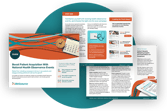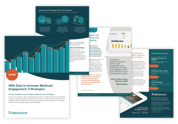Healthcare marketers, population health professionals, corporate wellness program coordinators— each of these roles are tied to the same goal: encourage individuals to take actions that will help them achieve optimal health.
Schedule that doctor visit. Quit that smoking habit. Sleep more, sit less, eat better.
No matter the action you’re trying to prompt, to build truly effective programs that encourage positive health and lifestyle changes one thing is essential: engagement. The success of any message comes down to the person receiving it, and if that person finds the message compelling enough to take action.
What is psychographic data, and why is it important in delivering health and well-being messages?
Psychographic data is a valuable tool for anyone communicating about health and wellness. In contrast with demographic profiles that consider quantitative data like age, gender, or income, psychographic data considers a population’s attitudes, motivations, and goals.
Why is psychographic data particularly helpful for health and wellness messages? Knowing two people have the same health concerns on paper doesn’t tell the whole story. What about their goals, motivations, and habits? Think of wellness as a path. Every person has a different starting point and will have different goals and priorities as they advance on their path.
In the past, there has been a “one-size-fits-all” approach to promoting wellness. After all, who can argue with the message that it’s good to be healthier? But as technology— and health and lifestyle data— advances, so has our ability to deliver more personalized health and wellness communications. Consumers have come to expect this individualized approach—and this makes sense. You wouldn’t communicate the value of exercise to marathon runners the same way you would a patient who is fresh off knee surgery.
It’s more effective to tailor your communications to each person, where they are in their health journey, and what their motivations are moving forward.
Collecting psychographic data for insights into health and well-being
In health and wellness settings, you can find insights into psychographics from a number of sources and digital behaviors. For example, consider the pages they visit on your website, or the ads they select in their search results. A patient taking multiple targeted health assessments or symptom-checkers could indicate a significant interest in health concerns. A comprehensive health risk assessment can collect valuable self-reported psychographic data, including mental health, attitudes toward the future, and readiness to change health and lifestyle habits.
Breaking it down: segmenting based on psychographic data
Building effective communications using psychographic data means looking for patterns and building segmented audience profiles based on those patterns. For health and wellness messaging, the importance of getting these profiles right is high—we're talking about a person’s health, here.
But how do you build your psychographic segments? One example is the PatientBond psychographic model, which was developed by healthcare consumer experts from Procter & Gamble and has been tested to be 91.1% accurate at identifying a consumer's psychographic profile among 5 different segments. Below is a rundown of the profiles, their approaches to health and wellness, and what motivates behavior changes for each:
| Profile | Attributes | Messaging Approach |
| Self Achievers | Proactive, invests in health and appearance. Stays on top of medical check-ups and screenings. | Responds well to goals, challenges, and metrics. |
| Balance Seekers | Wellness-oriented, open to many ideas and information on healthcare and treatment options, want to define their own success. | Responds well to having options and choices. |
| Priority Jugglers | Busy, with many responsibilities. May invest in their own wellbeing reactively, putting others first in order to prioritize family and duty. | Responds well to duty, caring for others. |
| Direction Takers | Look to healthcare professionals for direction, as experts and credible resources. | Responds well to specific instructions and directives. |
| Willful Endurers | Self-reliant, believes there are more important things to focus on than their health. They aren’t necessarily unhealthy, but rather live in the moment and have a hard time changing habits. | Responds to urgent needs, seeking help or changing lifestyle habits only when they must. |
If you’re interested in exploring this model, PatientBond has a 12-question survey you can take to learn which segment reflects your beliefs, values, and motivations.
You’ll notice that in this model, there is a continuum, from those most engaged and receptive to messages about health and wellness to those least engaged or interested in suggestions for change. The wide range of motivations and engagement makes it clear that different attitudes toward health need different communications and approaches. Each segment has its own unique preference for health and wellness communications, and different messages that will best motivate their next step in their health journey.
Example use case: psychographic segmentation to boost general wellness assessment
Here is an example of how psychographic segmentation might be used within a health and wellness campaign. Let’s say you’re promoting a general wellness assessment with a goal to get women ages 35-55 to come in for an annual exam. You’ve done market research that indicates this group may respond to messages that encourage them to take time for themselves, or that reframe annual visits as a form of self-care.
Below are example subject lines for an email promoting a general wellness assessment to this group, depending on their psychographic persona and the intended action you want them to take.
|
Subject Line |
Profile |
Why this strategy resonates |
|
“Prioritize your health” |
Balance Seeker |
This is an effective message for patients who understand the importance of their health but may not take time to invest in it. Acknowledge how busy they are—then reframe the assessment as self-care. |
|
“Understand your health habits” or “Is your xyz habit impacting your health?” |
Self Achievers |
This approach appeals to individuals who are more proactive in seeking a better understanding of their health. It frames lifestyle or health behaviors as something that can be understood objectively, so they can be proactive in their health. |
|
“Good health can’t wait” or “Better health is waiting for you” |
Willful Endurers |
This language creates a sense of urgency — they know they’ve put this off too long, and this is their opportunity to address it. Plays on a sense of obligation. |
|
“Free wellness assessment” |
Direction Takers |
As simple as this is, the specific and straightforward messaging makes it clear from the start what is being offered and what is expected from them. This kind of message may feel a little too forward, but when your audience is inundated with communications all day, this might just cut through the clutter. |
If you’re interested in exploring more subject lines to promote general wellness assessments, download our guide.
The better you understand your audience, the more your messages will resonate. Psychographic data helps you target your messaging with language that shows you understand their specific health concerns, motivations, or lifestyle habits.
More tools for engagement:
|
|
|
|
Creating a Culture of Health for corporate wellness managers and wellness programs |












